
| Touching Bases | April 14, 2009 |
I’ve hypothesized, along with others, that Ryan Howard might be the best opposite-field power hitter of all time. Thanks to the wonders of Retrosheet (and Colin Wyers), we can get closer to answering that question.
I queried for all home runs in the retrosheet era, and came up with about 185,000 homers. I then tried to eliminate all home runs that didn’t have a field location or were inside-the-parkers. That cut around 20,000 homers. And not all the homers cut were from the 50s. I think the worst year for data on home run location in the retrosheet era (1953-2008) was 1984. The most accurate years are probably during the ‘90s. Anyway, Here’s the diagram retrosheet uses. I coded all three zones left/right of center as pull/opposite field respectively, and the straightaway zone as center field. Onward.
+----------+---------+-----------+-----------+ | Bats | Pull% | Center% | Opposite% | +----------+---------+-----------+-----------+ | Left | 76.3 | 11.8 | 11.9 | | Right | 76.6 | 12.1 | 11.3 | +----------+---------+-----------+-----------+
Somewhat odd that lefties hit more opposite field homers than center field homers. This won't really shed light on the matter, but I felt like looking at splits against pitchers.
+----------+-----------+---------+-----------+-----------+ | Bats | Pitches | Pull% | Center% | Opposite% | +----------+-----------+---------+-----------+-----------+ | Left | Left | 77.6 | 11.6 | 10.9 | | Left | Right | 76.0 | 11.8 | 12.1 | | Right | Left | 77.0 | 11.7 | 11.3 | | Right | Right | 76.4 | 12.3 | 11.2 | +----------+-----------+---------+-----------+-----------+
So it appears that lefty pitchers have their homers pulled more often than righty pitchers—likely a result of southpaws being softer throwers. I wonder why lefties appear to hit homers to the opposite field against righties at an abnormal rate.
Alright, let’s look at the top home run hitters of all time.
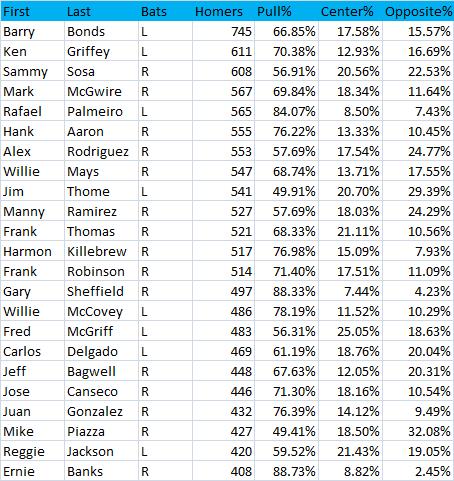
This was a convenient place to stop, as the next three in line hitters were switch hitters in Chipper Jones, Mickey Mantle, and Eddie Murray. Unfortunately, I messed up coding home run locations for them.
I had a feeling Jim Thome hit a very high percentage of homers to the opposite field. He and Ryan Howard are linked in more ways than one. I have to give credit to Rich Lederer for guessing that Mike Piazza would be among the tops in percentage of homers to the opposite field. But just wait until we get to my man Howard. Sheffield, not surprisingly, pulled twenty times as many homers as he hit the other way. I can’t say that I knew Ernie Banks was that extreme a pull hitter.
With a minimum of 100 home runs in my sample set, here are those with the highest pull percentage.
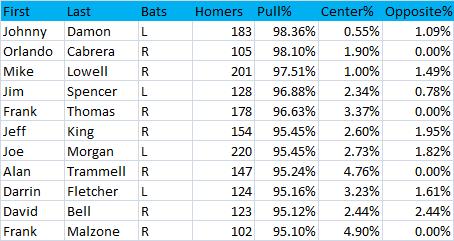
No, not that Frank Thomas. You can see his splits above on the all-time leader list.
These are guys who don’t have the power to hit it out any other way. I’m impressed that so many batters have hit 100 homers without using an entire third of the field. The only other member of this group is Don Baylor, who hit 277 homers without an opposite field blast. I wanted to check on Ichiro Suzuki, since he fits in this school of hitters, but didn’t reach the 100 home run threshold. He’s hit a single opposite-field home run in his career. I hope it was memorable.
Center Field Percentage

Mike Marshalls have played a large part in my life over the last year. I recently learned that one Mike Marshall was as an outcast Cy Young award-winning former teammate of Jim Bouton, who later became a doctor who developed radical pitching mechanics. Now I know that the year he retired another Mike Marshall, of whom I had never heard, debuted as an impressive home run hitter to center field. They both had their best years with the Dodgers.
These guys all seem to have tons of raw power, as that’s what it takes to hit balls out to center. Chipper Jones belongs on this leaderboard, but was excluded due to my glitch with switch hitters.
Opposite Field Percentage
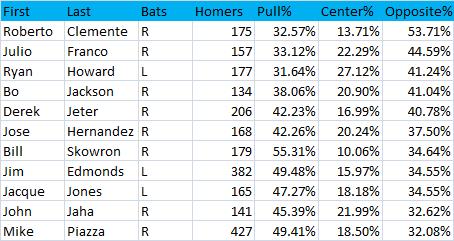
It’s always a pleasure to see Roberto Clemente top any list. The fact that he was such an extreme opposite field power hitter might be a tidbit not many knew about, so I’m glad I can contribute one of the more trivial pieces of information to his legend. I’m surprised to see Julio Franco here. I saw a game or two of his in my day (who didn’t), and I always thought his unique batting stance would be conducive to pulling balls, kind of like Gary Sheffield’s bat wiggle. I guess holding the bat parallel to the ground delays his swing so he makes contact with the ball as it travels further in the zone. Chuck Knoblauch, who was the opposite of Franco in that he held his bat practically parallel to the ground behind him instead of over his head, pulled 75% of his homers. Also irrelevant: Franco's hit multiple homers against both Oil Can Boyd and Russ Ortiz. I doubt many others can say that.
So Ryan Howard is clearly up there. When I made my claim about Howard, it was after seeing that he was the only player in the last four years to have recorded greater than 15 homers in a season to his weak side. I was looking at Baseball Info Solutions data then, which has Howard’s 177 career homers distributed as 37.29% to left, 32.20% to center, and 30.51% to right. So the center field zone I’m using is a bit smaller than that of BIS. I think we can say pretty definitively that he’s a great opposite-field home run hitter, but Clemente seems to be in a class by himself when it comes to opposite%. I assume that Clemente’s and Skowron’s opposite field numbers are somewhat inflated, since their center field numbers are depressed as a result of the much deeper fences back in the day. Additionally, the right-field line at Forbes Field was 300 feet, which may have padded Clemente's totals.
Was Bo Jackson the beginning of the hype machine? Or was it Brian Bosworth? I believe that Bo Jackson hit a home run to the opposite field so far that it went into orbit, only to be knocked down by a homer Matt Wieters hit last week, which I’m sure will in turn be bumped by Stephen Strasburg and then Bryce Harper.
Derek Jeter’s opposite-field prowess is well known, and I believe he’s the only batter in this group to have added to his tally this year. (I wrote that, and then on Monday, Howard hit a three-run shot to left-center field. We’ll have to see where they score that one.)
On to the single season leaderboards.
Single Season Pulled
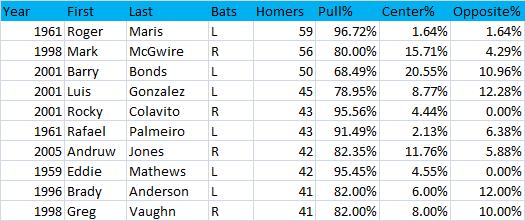
Roger Maris is the home run king!
Single Season Center Field
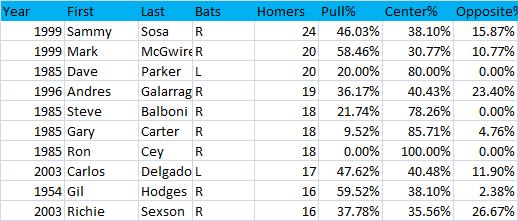
Chipper had 17 in 1999 as well, but he is not included. '99 was an interesting year. 1985 was also an interesting year. Clearly, home run location data from that year are not reliable.
Finally, here's the leaderboard that started this whole ordeal.
Single Season Opposite Field
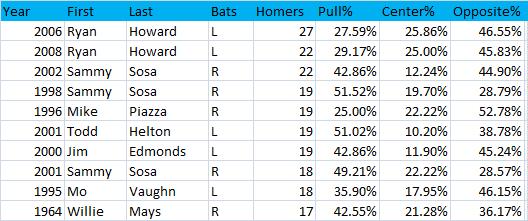
There you have it. Howard is demonstrating opposite field power the likes of which we have never seen before.
Actually, one more note. Since I regret messing up the coding for switch hitters, I decided to go back and check on the five most notable I could think of in Mickey Mantle, Eddie Murray, Chipper Jones, Lance Berkman, and Mark Teixeira. Here are their career splits.

Looks like Murray and Teixeira were similar from both sides of the plate while Berkman has a split personality.
If you've made it this far, here's something that might interest you. In a google docs spreadsheet, I’ve included all batters with 50 career home runs in my dataset and on another sheet all batters with seasons of at least ten recorded home runs. If you want to search for a specific player, I’d suggest that you check out baseball reference's home run logs. Sean Forman does good stuff over there.
Comments
Great stuff. This was very interesting. One thing: I'm guessing in the Single Season Pulled chart that the year is wrong for Rafael Palmeiro? I never realized how pull-happy he was, as well.
Seeing these charts definitely reminded me how many times Sammy Sosa went yard oppo. He's a name that slipped my mind when I was reading the intro.
Posted by: Mike R at April 14, 2009 12:20 AM
You forgot Mike Schmidt in your lists.
Posted by: Matthew at April 14, 2009 6:35 AM
CORRECTION: You forgot him in the first list of the top home runs hitters of all time.
Posted by: Matthew at April 14, 2009 6:37 AM
Yeah, my bad guys. I'm not sure what happened in either instance. With Palmeiro, I must have for some reason manually changed the year. It was actually 2001. As for Schmidt, I guess his home runs just often weren't accounted for in the retrosheet years. He only has 265 in my dataset. 65% pull, 25% to center, 10% opposite.
Posted by: Jeremy at April 14, 2009 7:08 AM
When Canseco first came up he seemed to hit a good share of opp HR's but maybe after his 10,000 Stances phase he lost that.
As far as LHB hitting more opp field, how much might Fenway skew that data (or even a couple of years of LA Coliseum if that was included)?
Posted by: Gilbert at April 14, 2009 9:54 AM
I am old enough to have watched Roberto Clemente's career beginning in 1960. Forbes Field was 365 feet to left with a high wall, and only 300 feet down the RF line with a very high screen. Nearly all of the Pirates RH hitters with some power hit to the opposite field. Mazeroski and Clendendon (to name two) hit many more HR on the road than they did in Forbes Field. In my memory, Clemente almost always hit to right.
Posted by: Phil at April 14, 2009 10:06 AM
Great article.
One note, though: in the single-season charts, the "Homers" column isn't "All homers hit by this player in this season", but "The number of homers this player hit that the chart is looking at". So Maris looks like he has 59 home runs in 1961, when what the chart means is that he had 59 pulled home runs. Which is still kind of a lot.
Posted by: Monty at April 14, 2009 11:49 AM
Gilbert, good stuff. I just realized I didn't include righties in the spreadsheet I linked to. I'll get on fixing that. But you're right on about Canseco.In the first seven years of his career ('85-'91) he was 64% pull, 20% center, 16% opposite. After that he was 77% pull, 17% center, 6% opposite until 2001.
Phil and Gilbert, I probably should have addressed parkf actors more. I briefly mentioned Forbes might have been a boon to Clemente, but the Coliseum and Fenway sure would inflate LHB opposite field homers. Let me check on that. I queried for the Coliseum and Fenway, and for lefties their split was 77.0% pull, 3.7% center, 19.3% opposite. All other parks combined were 68.2% pull, 13.6% center, 18.1% opposite. So great find Gilbert. Forbes for righties was 77.0% pull, 3.7% center, 19.3% opposite, so you were right on the mark too Phil.
Posted by: Jeremy at April 14, 2009 1:05 PM
EDIT: I messed up what I meant to write for park factors. Fenway and Coliseum for lefties were 68.2% pull, 13.6% center, 18% opposite. All other parks were 76.6% pull, 11.7% center, 11.7% opposite. Forbes for righties was 77.0% pull, 3.7% center, 19.3% opposite. So they were both better than 50% more likely to have opposite field homers than neutral parks.
Posted by: Jeremy at April 14, 2009 1:17 PM
Monty,
You're right. I should have included home runs to each field if I was going to sort by total instead of percentage. My bad.
Posted by: Jeremy at April 14, 2009 1:31 PM
It looks like you have Palmeiro and Colavito switched around. Colavito was 1961 and Palmeiro was 2001.
Posted by: Kevin at April 15, 2009 5:39 AM
As long as we're on park effects, Berkman benefits from a short porch in left and Mantle had a short porch in right, so the difference in their splits is hardly surprising either.
I'd be interested to see if someone like Bonds' percentages change as his body "developed." Unfortunately, of course, he's got a couple of park changes in there that would complicate the numbers slightly.
Posted by: Preston at April 15, 2009 6:03 AM
ooh, what font are you using in your tables?
Posted by: nerd at April 15, 2009 6:17 AM
Excellent article. As you noted, incomplete data can make it hard or impossible to get complete results. Do you have any stats for Jimmy Wynn, Yaz, Frank Howard or Willie Horton?
Posted by: Al Doyle at April 15, 2009 6:36 AM
I remember growing up watching Dale Murphy and Mike Schmidt hitting HRs the other way (it seemed like always.)
I wondered about this as a kid, if maybe RH batters had an advantage on hitting outside pitches with authority because during their weight shift, they in essense lean towards first base on that type of pitch/swing. I figured that lefties laid off of the outside pitch more because they "lose" a step towards first. It seemed like there were more lefties who pulled the ball than righties.
Nothing scientific on my part to back it up, but I thought about it when I read your story. Good stuff.
Posted by: TZig at April 15, 2009 7:40 AM
From a Padres fan perspective I would be interested to see how Phil Nevin, Nate Colbert and more recently Adrian Gonzalez have done.
Any chance you could do a break down by team history?
Posted by: websoulsurfer at April 15, 2009 10:33 AM
Fascinating stuff. Re: Berkman's split personality: he spends more time hitting lefty, clearly, and half his games are at Minute Maid with a short left-field porch, which boosts his righty pull numbers and his lefty opposite-field numbers. It would be extremely surprising if he, or any switch-hitter for the Astros, didn't have this kind of split, really.
Posted by: Barnwani at April 15, 2009 6:24 PM
Thanks for all the comments. Sorry it's taken me a while to respond.
A few of you asked for data on certain players. I included most of my data in the google spreadsheets linked to at the bottom.
Jimmy Wynn was 82/14/4, Yaz was 63/15/22, so great power to center and the other way. Frank Howard was 64/23/13, and Horton was 78/10/12.
The Yankee stadium short porch is an obvious one that clearly aided Mantle and Maris. I didn't realize that about Berkman, but it's a fair explanation.
Preston, the tables are copied and pasted from Excel. It's whatever default font they use in the 2007 version.
Tzig, interesting idea. But I think the main determinant is where the bat makes contact, and if the ball is deeper in the zone, it will be hit the other way. So if they faced neutral velocities, we don't know who would pull the ball more (I'll hopefully be able to study that.), but lefties face harder throwing pitchers.
Websoulsurfer, I'll do a team by team breakdown on Tuesday which will have used Hit Tracker data over the last couple of years, though it won't focus so much on location. Adrian is 52/21/28. He's the only player in the game, now that Thome has slid, who can rival Howard's opposite field power. Colbert was 83/8/9. Nevin was 58/13/29.
Posted by: Jeremy Greenhouse at April 15, 2009 6:52 PM
The default font for Microsoft apps on the PC these days is called "Calibri".
Posted by: Jason at April 16, 2009 2:49 PM